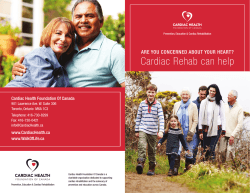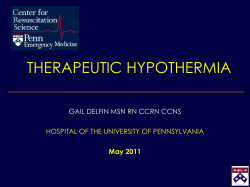
IMPROVING THE ODDS FOR CARDIAC ARREST
HEART AND STROKE FOUNDATION RESEARCH: SAVING LIVES — CARDIAC EMERGENCY IMPROVING THE ODDS FOR CARDIAC ARREST A massive Canada-U.S. resuscitation study is laying the groundwork for improved cardiac arrest survival rates. Heart and Stroke Foundation researcher Dr. Laurie Morrison Cardiac arrest can occur at any age, at any time, without warning. It can be triggered by a traumatic injury, such as a car accident or drowning; or can result from a heart attack brought on by a blockage in a coronary artery. largest clinical research initiative of its kind in the world. studies have already seen incredible improvements in survival rates. Out of the estimated 40,000 cardiac arrests that occur in Canada each year, most (85 per cent) strike suddenly and unexpectedly in places outside of hospital, like your home, the office or in a public setting. It is testing promising new resuscitation drugs, tools and interventions to give survivors of cardiac arrest or trauma a better chance of survival. Trials taking place in Ottawa, Vancouver and Toronto include extensive data collection and interventions performed by participating local Emergency Medical Services (EMS). ROC studies compare treatment options so that EMS providers can identify the best early interventions to improve patient survival. “Since our clinical trials began in 2006, the survival rates of out-of-hospital cardiac arrests in our Toronto and adjacent regions have increased fivefold,” says Dr. Morrison. Currently, the chance of surviving an out of hospital cardiac arrest in Canada is a dismal five per cent. Without rapid and appropriate treatment within minutes, most victims will die before reaching the hospital. The Heart and Stroke Foundation co-funds the Resuscitation Outcomes Consortium (ROC), a $50-million Canada-U.S. research collaboration, the Dr. Laurie Morrison leads the Toronto ROC Coordinating Centre called Rescu, which is currently enrolling patients in two studies designed to test new CPR techniques and the use of drugs to treat ventricular fibrillation (chaotic heart beat). She notes the ROC Join us in the quest for healthy lives free of heart disease and stroke. Donate to the Heart and Stroke Foundation. Together we will make it happen. heartandstroke.ca “By improving the quality of CPR and EMS techniques and response times, survival rates may surpass the current rate of 11 per cent. If this five-fold increase in survival was translated into every community in Canada this would save an additional 4,800 Canadian lives a year.” ROC research is providing the largescale proof necessary to support widespread adoption and delivery of new and improved medical protocols to empower bystanders, hospital staff, paramedics and other frontline workers to save more lives. HEART AND STROKE FOUNDATION RESEARCH: SAVING LIVES — CARDIAC EMERGENCY SEVEN TIMES UNLUCKY BUT SURVIVING Kevin believes the AED saved his life, along with the bystanders who were trained and ready to keep cardiac arrest from taking another life. Kevin Vinding, Dustin Vinding (son), Coral and Crystal Vinding (daughters) Kevin Vinding experienced seven to be watching the game and a Thankfully, Kevin suffered no brain cardiac arrests in one night and lived. teammate who was a firefighter rushed damage, which he credits to measures He credits the right people and the to Kevin’s side and began performing taken by EMS and hospital staff. CPR and shocked his heart back to life He now has two stents in his left right life-saving device being on hand to bring him back to life during a with an AED. hockey game at the Jemini Arena in Luckily, an ambulance just happened to lifestyle changes including quitting Saskatoon. be driving down a street near the arena smoking, eating healthier and going to Just a few minutes into the third-period at the time the 9-1-1 call was made and the gym regularly. of the game, Kevin went into cardiac arrived within minutes. Kevin believes the AED saved his life. arrest and collapsed to the ice. Kevin, who was 44 at the time, later Just as important, there were people Thankfully, there were people trained found out that only three per cent of nearby who were trained and ready in life saving CPR and use of an people survive what he did. to stop cardiac arrest from taking its automated external defibrillator (AED) His wife was told he might not make it at the rink that night. A coronary care nurse, who happened through the night and if he did, it was likely he would have brain damage. Thanks to your support, research is creating survivors by enabling faster, better cardiac emergency response and treatment. Help create more survivors. #CreateSurvivors coronary artery and has made major next life.
© Copyright 2025





















